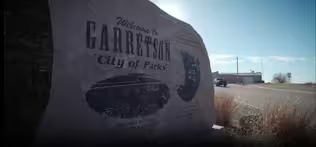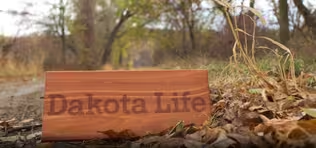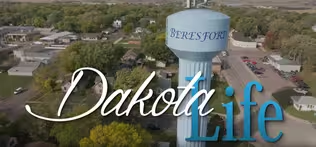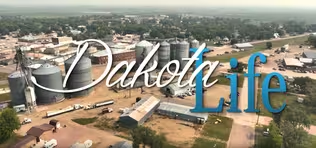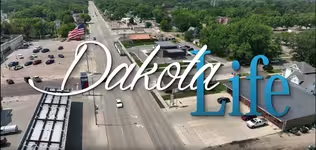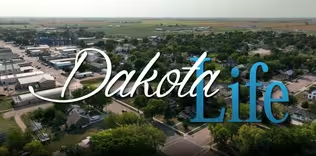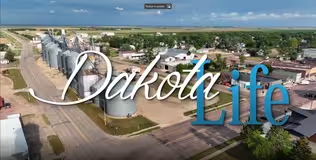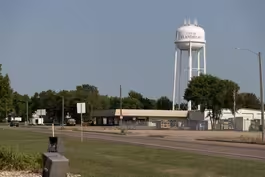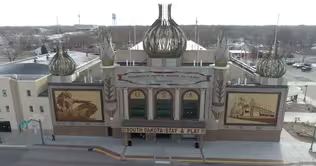Dakota Life
Greetings from Newton Hills
Season 23 Episode 5 | 28m 5sVideo has Closed Captions
Dakota Life showcases Newton Hills and the SD State Park system.
Greetings from Newton Hills, just south of Canton, South Dakota. Dr. Beth Jensen welcomes SDPB to her farm just outside of Sioux Falls. Cattle brands are part of a family business identity. Dr. Craig Howe and Dr. Vine Deloria Jr. share the meaning behind a snake effigy. The Konechne family diversify their farm with a pheasant lodge. Meet Byron Pudwill, head coach for Bon Homme football.
Problems playing video? | Closed Captioning Feedback
Problems playing video? | Closed Captioning Feedback
Dakota Life is a local public television program presented by SDPB
Support Dakota Life with a gift to the Friends of Public Broadcasting
Dakota Life
Greetings from Newton Hills
Season 23 Episode 5 | 28m 5sVideo has Closed Captions
Greetings from Newton Hills, just south of Canton, South Dakota. Dr. Beth Jensen welcomes SDPB to her farm just outside of Sioux Falls. Cattle brands are part of a family business identity. Dr. Craig Howe and Dr. Vine Deloria Jr. share the meaning behind a snake effigy. The Konechne family diversify their farm with a pheasant lodge. Meet Byron Pudwill, head coach for Bon Homme football.
Problems playing video? | Closed Captioning Feedback
How to Watch Dakota Life
Dakota Life is available to stream on pbs.org and the free PBS App, available on iPhone, Apple TV, Android TV, Android smartphones, Amazon Fire TV, Amazon Fire Tablet, Roku, Samsung Smart TV, and Vizio.
Providing Support for PBS.org
Learn Moreabout PBS online sponsorshipMore from This Collection
Dakota Life stories from towns in southeast South Dakota
Greetings from Wessington Springs
Video has Closed Captions
Most cities shape the landscape they’re on, but in Wessington Springs it’s the other way around. (29m 45s)
Video has Closed Captions
Discover the beauty and history of Palisades State Park, goat yoga, and a very special love story. (29m 46s)
Video has Closed Captions
Beresford hosts the Frostbite 4, a regional favorite winter road race. (26m 26s)
Video has Closed Captions
From a window to the past to raising the next generation, Dakota Life explores Wagner. (28m 53s)
Video has Closed Captions
Greetings from Madison, the center of Lake County. (28m 55s)
Greetings from the Corn Palace
Video has Closed Captions
Greetings from the Corn Palace plus stories from southeast South Dakota and Aberdeen. (26m 16s)
Providing Support for PBS.org
Learn Moreabout PBS online sponsorship(upbeat music) - The natural beauty of South Dakota is preserved in our 56 state parks.
Just as important, the park system provides public access to recreational activities.
(children shouting) Between the warm summer and concerns about coronavirus, this has certainly been a time for outdoor spaces.
In fact, the state parks set a record in 2020, with a visitation of nearly two million, but there's never a bad time to get outside and enjoy some fresh air.
Welcome to Dakota life, and greetings from Newton Hills State Park.
Many of our state parks are adjacent to rivers or lakes, but several others showcase rolling hills, woodland areas, and hiking trails.
Such is the case here of Newton Hills, and all along the Coteau of Eastern South Dakota to Sica Hollow State Park, near Sisseton.
That park is a haven for hiking, bird-watching, and trail riding, and Native lore tells of spirits that reside within the woodland at Sica Hollow.
We'll have more on our park visit coming up, but first, we're headed to a site on private land just east of Pierre, where Native lore connects land and Inyan, a stone spirit of tribal mythology.
It's a snake effigy made of rock, and the legend is as fascinating as the imagery.
- [Phil] Saswe had this sort of period of time that people often do before a vision or a vision quest, where, you know, he was hearing voices that were calling to him.
He knew that he was part of a kind of a spiritual encounter that was gonna happen at a certain point.
(ethereal music) They ended up camping at the Medicine Knoll near Blunt, and he went up there to have his vision, and when my grandfather was told, it was that you could do a vision by standing and praying with the pipe, or you could do a vision in a somewhat different way, by digging a kind of a hole with a kind of a little seat in it, and then you would put your head down, and you would wait, and there's a tiny, little other part of the story that also my dad tells in the book, which is that his cousin Brown Bear was sent up to check on him, to check on Saswe, and Brown Bear rode his horse up the Medicine Knoll and was stopped by all of these rattlesnakes, and the snakes, you know, kind of would not let him pass, and he had to spur his horse, and then very, very, you know, traumatic, I think, to sort of imagine this, right, these snakes, but you feel like you have to go, and he couldn't quite get there, but he, you know, got to the point where he could see Saswe, and he saw snakes crawling all over his body, and Brown Bear, at that point, you know, kind of turned and went down, you know, with his horse, and he had been sort of forcing his horse to go, and went back down into the camp and said, "Oh, you know, my cousin is dead up there," and the people started mourning, and at that point, Saswe, you know, in the middle of this mourning practice, Saswe came down off the hill and, you know, and there he was.
(ethereal music) - Another thing about these effigies out of rocks, I mean, rocks are not just rocks in Lakota cosmology.
This idea of these rocks are from their origins, from the beginning of time from a Lakota perspective.
This is a being, this is, how to say that?
These rocks are evidence of this original being called Inyan, and he was what was here at the beginning.
Inyan, and eventually, Inyan, which I just love the phrase, "He pulsated with the potentiality of the universe," so this being eventually, through processes that are in Lakota cosmology, that he bled out and went from this amorphous, powerful being to this hard, brittle substance that we call rock today, so any of these rocks are, in Lakota cosmology, they're referencing Inyan, that original being.
So to use them to make a shape of anything can have these really strong cultural significance.
- [Phil] The people on this landscape, right, knew this landscape cold, you know.
I mean, they knew everything about it.
They traveled all over it.
They understood it in great detail, and, you know, these kinds of places, these medicine knolls and buttes, this feels to me like something that was knowledge that was held collectively by people for a really long time.
(ethereal music) - There is a similar connection to Native lore at Good Earth Park at Blood Run, just east of Sioux Falls.
That site was an important gathering place for seasonal ceremonies and a significant trading center for many tribal peoples as far back as the 13th century.
Here at Newton Hills, like at Good Earth Park, there's wooded areas and open prairie.
They feature extensive trails for winter hiking, but when the snow flies, you can join others and enjoy snowshoeing.
Now, whether you're in the game or just watching, sports can connect a community.
Since 1982, Springfield, Tabor, and Tyndall have been connected as the Bon Homme School District, and for that nearly four decades, only two men have held the position of head football coach for the Cavaliers.
The passion of Russ Morrell and Byron Pudwill has led the traditions and consistency that the program has today.
- So you're gonna roll your hips, drive for five.
Here we go.
- [Coach] Go ahead, Randy.
(speaking faintly) (whistle screeching) - Reffy!
Newcomb score.
- Being a Cavalier, it's a blessing.
We have our whole community behind our back, and we have all these people that are cheering us on, and the last two years have been really surreal for us.
It's been a really good time to be a Cavalier.
- Pistol left, three list, two quick screen.
Now 101, ready?
(everyone clapping) - [Coach] Left, lean left.
(inspirational music) - It's whatever you like, but most of the locals, I think, just rattle off Bon Homme, but if I'm doing an interview or calling somebody on the phone, looking for a new football, it's Bon Homme, so it can go either way.
- Yeah, you're trailing him.
He's trying to hang on to the ball while you're coming behind, (pads smacking) and you're gonna try to punch it out.
- [Tom] Since 1982, the Bon Homme School District has consisted of three communities: Tyndall, Tabor, and Springfield, and since that point, only two men have coached the Cavaliers Football Team: Russ Morrell, from the beginning until 1999, and then Byron Pudwill, from 2000 to present day.
- 3-0, chopping the feet, go!
(players groaning) (footsteps falling) - [Tom] For nearly four decades, football at Bon Homme has been one of the most consistent programs in the state.
Most will tell you it's because of the guys who have been in charge.
- When you think of Bon Homme football, you'll always think of Russ Morrell, Coach Pudwill.
Those guys have been here forever, and that'll never be forgotten that way.
- [Tom] The Cavaliers had many winning seasons throughout the '80s, but the mid-'90s put the program on the map with two state championships.
(crowd roaring) - So, this time he hands off to Ranek, and he is, no, he's in!
(crowd cheering) A late signal, touchdown Bon Homme, and it's Josh Ranek.
- It was pretty awesome, you know, coming into it.
You know, back in '89, prior to that, we had a team that was right there, a heartbreaking loss against Sioux Valley back then, and we knew how much it would mean to the community and the school and to us, you know, the work we put into it.
It was a pretty awesome situation, I mean, great memory I'll never forget.
(upbeat music) - Everybody did their part, and it came out the way we needed it to have it come out.
- I was coaching there with Russ, and it was a tie game.
You know, one of 'em was 7-6.
I think the other one was 6-0 or 7-0.
Good old 11B football back in the day, and I remember being super-super-locked in to the game 'cause it was so tight.
They had that Poppinga kid, and we had Ranek.
So A, from one perspective, you didn't wanna miss a play, and B, you didn't want 'em to pop a touchdown.
To look up there and just see them jam-packed.
It was, it was crazy.
- [Tom] At the turn of the millennium, Coach Morrell moved on to coach at Wagner.
It was his long-time assistant Pudwill who then moved up to the head coaching spot.
- Obviously, Byron learned from Russ, so a lot of the stuff that Russ did, we still do.
I think he tries to adopt all of those same qualities.
Obviously, as humans, we're all built a little different.
We're wired a little different, so Byron's wired to be more emotional, probably like me, which we always talk about good cop, bad cop, so as long as you have a mixture, it all works out pretty good.
Okay, on the snap, but if you guys re-run, you guys are backpedaling.
Here we go.
(melancholy music) - [Tom] In 2014, Coach Morrell passed away, but his legacy as a coach, person, and father live on today.
- Well, one of the coolest memories I have of playing college football is when my dad would travel to the 1996 national championship game, when we won the national championship.
Now, my parents were both teachers in South Dakota and didn't make very much money, and so it cost 'em a lotta money to travel all the way to that game, and I just still to this day, so appreciative that he made the effort to be there and to support me, and obviously, it's one of the things that I miss the most about him, is the fact that I can't talk football with him.
(melancholy music) - And we're just lucky enough that we got one in, and that's the difference in the game.
Can I say one thing to my son?
(spectators cheering) All right, Chuck, this is for you, bud.
- [Announcer] Russ Morrell!
- He's my mentor.
He is my, you know, if I know anything about coaching, it's due to him.
You know, I was coming in, I was about as green as you could be, or any, it was my first year.
I mean, experience was zero.
I'm not sure what I said on the interview.
I must've made something up.
I don't know, but everything coaching-wise I have, I owe to him.
- [Announcer] The head coach of the Bon Homme Cavaliers is Byron Pudwill!
- [Tom] Pudwill led Bon Homme back to the Promised Land in 2018, where the Cavaliers won their third state title in program history.
(spectators cheering) - He's a pretty good coach.
He knows what he's talking about.
He'll tell you exactly what you're doing wrong and how to deal with it.
Do something wrong, and he'll get on you.
- He's a great coach.
He truly cares about each and every one of us.
He's there when we lift.
He's always on us if we're doing something, and he's trying to correct us, and he's a great coach.
- Go, go, ready!
- Byron's done a phenomenal job, and you know, really, when you wanna say one thing, it's about consistency.
1980 through today, we're talking 40 years, and only two head coaches during that time, in 40 years, and obviously, you know, Byron was an assistant for many years for my dad while he was at Bon Homme, and so, you know, I think that speaks of why there is a tradition with the football program at Bon Homme.
(energetic music) - The football season is over, but there's no reason to stay indoors.
Here at Newton Hills, you can hike the trails in winter and look for some of the over 200 species of birds that visit the area each year.
There are whitetail deer, wild turkeys, marmots, rabbits, red and gray fox, and squirrels, and when the conditions are right, snowshoeing and cross-country skiing too, but if you wanna stay indoors, there is the historic Newton Hills Lodge.
It was built in 1915, and it was the home of the park caretaker but now is a guest rental that sleeps up to 12 guests, and Newton Hills is the first in the park system to have a new two-bedroom modern cabin, and more like this one are likely coming to other parks.
Just outside of Sioux Falls, a family medicine physician uses her farm as a getaway to de-stress for her own wellbeing, but the outreach of the getaway extends to a virtual learning experience, allowing children to connect with rural life and the animals that inhabit it.
(birds chirping) (insects chattering) - [Tom] Get out your vehicle at this farm (rooster crowing) near Garretson, and chances are you'll get a warm and fuzzy welcome.
(lamb bleating) Dr. Beth Jensen and her family adopted these orphan lambs.
They're just a few of the dozens of animals on the farm and are part of a program created by the Jensens called Glean for Good.
Glean means leftover crops.
- Yeah, this is where we collect our eggs.
- [Tom] The Jensens are living off the land, doing everything from growing vegetables to making their own maple syrup.
- This vision started out, like, literally as seeds and saplings and has grown into something which, there's a place to come experience this kind of life out here, and it has become a teaching ground so that especially the generation of my own kids are able to come out and see that they can do that for themselves.
- [Tom] The idea was born out of a doctor's concern for the health and well-being of her patients.
She now lives a lifestyle she can share.
- Gradually, at a pace that we can keep up with, has allowed us to have this more sustainable lifestyle and has allowed us to be outside more, be more physically active, be more connected with our own family, our immediate family, but also within the community.
- [Tom] Jensen says reaching out to kids is especially rewarding.
They get to see, smell, feel, and hear.
(pig snorting) (chickens clucking) Animals like Tank, the Kunekune pig.
- And then yeah, the kids love to eat off of, (laughs) so sometimes if I dump the food, and it lands on top of Tank, then the kids'll jump right on him.
(animals snorting) But they all get along so well.
It's just kind of a miracle.
(laughs) - [Tom] Before the pandemic, Jensen welcomed groups of children, roaming the grounds and meeting the animals.
- Oh, yeah, you wanna go climb that mulberry bush and pick some berries, go ahead!
You wanna go chase around the lambs around the house a couple times?
That's, that's fine.
There's really no way for them to get into much trouble out here, and that's by design.
- Nice, so what's her personality like?
Who is Ginger?
- [Beth] (laughs) So, Ginger is, well, so in general, she's pretty shy, but once we catch her, she usually is, she loves the camera.
- [Tom] Because of COVID-19, the extensive tours are on hold, so Dr. Beth is taking Glean for Good into people's homes over the internet via Zoom.
During a scheduled GleanScreen session, as she calls it, classes, groups, and gatherings of all sizes get up close and personal with the animals like Ginger, the llama.
She's the farm's most popular animal.
- And I also have really enjoyed just trying to customize the experience so that the animals are maybe doing something, wearing something, you know, that's especially fun.
I don't know if you noticed, but one of our lambs is wearing a PBS shirt.
I don't think he came up to me.
Let's see here.
So, but you know, to just kinda discover these fun little things and yeah, are you, are you a friend of public broadcasting?
Look at you!
(laughs) (chickens clucking) But we would love to really open this up to the rest of the world, and so I just, if nothing else, I just want people to know we have a sense of humor about it.
We don't take ourselves too seriously, but we really hope that people just wanna be a part of this with us, and yeah, that's it.
(laughs) (teeth chewing) - Having some time to take personal inventory or help others is essential to a healthy lifestyle.
We're fortunate to have outdoor public spaces set aside for all of us to enjoy.
From here in Newton Hills south to where the Sioux River joins the Missouri River is the Adams Preserve and Nature Area, and no park entrance fees are required there.
You can enjoy the hiking trails, archery range, cross-country skiing, or learn more about the homestead history.
There's a lot of history in the tradition of branding.
It's a long-standing means to identify livestock, but there are powerful memories in brands, and some families hold on to them even when they're not in use.
(flames whooshing) (cattle lowing) - What makes a good brand?
A good fire and a good iron, and somebody that knows how to run it.
It's getting that so many brands recorded anymore, and nobody goes to the trouble of changing the shape of brands or like that anymore.
If they're gonna steal cattle, at least take the cattle and rebrand 'em, or easier to take the money.
It's easier to steal paper than it is cattle, but so the cattle theft business, I think, has went down over the years, so people don't keep track of their cattle as good as they used to, and I don't feel like as a whole that people know how to brand as good as they used to, but that's just one man's opinion too.
(laughs) (cattle lowing) - A good brand is one that goes on easily, won't blotch, and is very legible, very easy to read.
And just like everybody makes jokes about doctors' handwriting, it's the same thing with brands.
When you put a brand on, you want it to look crisp and legible so that you can see it from a distance.
The cow we got this morning, we were probably 50 yards away or maybe even 100 yards away, and I could read the brand on that cow's side and recognize it and say, "Oh, yeah, that belongs to my neighbor."
When you look at this South Dakota state brand book, it's terribly thick, and there's a lotta brands in there, so when someone new comes into the industry and wants a brand, it's very hard to get a good brand that actually works, and when I say works, it doesn't blotch, it's easy to put on, it's easy to read.
- This is a 1937 brand book, and the size of it, (clears throat) and then, brand books are published every five years, so this was the last brand book that we published in 2015, and if you can see the difference in the thickness of where we come and in the number of brands that we have.
Brands have a lotta sentimental value to individuals because they identify that person's livestock, and so there's a lot of brands where, you know, someone's grandfather may have used it and passed it down, but there's no longer anyone operating a ranch or in a need for it, but because it was something that their grandfather had originally registered, they continue to keep the registration current.
(cattle lowing) - It is a family crest, and the old expression, "You ride for the brand."
When you hire on to work for a ranch, you're loyal to that ranch.
That's your first loyalty.
You know, we don't work a lot of nine-to-five days.
There's certain times of the year where things slack off, but especially like during calving time and in haying time, I know in certain times and storms during calving, blizzards, you basically are working 24 hours a day.
You might catch a cat nap now and then, but you're just, you're there till the job is done, and so if you're loyal to the brand, you don't shirk.
You're proud of the fact that, you know, you can do this work, and you do it.
- Now, this is the first year in our survey, in our brand renewals.
We hope to find out how many brands out there that are not currently being applied to livestock.
So once we get done, and we'll have all the survey question information, we'll be able to compile that and actually get somewhat of an accurate information on how many are actually being used and those that are just being kept for sentimental reasons.
(cattle lowing) - Maybe the most recognizable brand in the park system is the 71,000 acres of Custer State Park in the Black Hills.
There is year-around scenery with pine forests, granite peaks, and pastures.
You can hike and cross-country ski in the winter, and the Mickelson Trail bisects the park too, but remember, remain in your vehicle, or stay at least 100 yards away from the bison, elk, and other animals in the park.
Here at Newton Hills, as in some parks around the state, the winter activity may be hunting.
October through April, bow-hunting is allowed in the park, but a note for visitors: hunters will not be using the high-traffic areas near the hiking trails, and there are bow and firearm restrictions within the campground and picnic areas.
Pheasant hunting is a generations-old tradition.
For decades the Konechne family has hosted hunters on their farm near Kimball.
It's their way of sharing the tradition with family, friends, and hunters from across the nation.
(gun firing) - Whoa, nice shot, nice!
- [Host] Hunting is a Konechne family tradition.
They enjoy sharing with others.
- Yeah, hunting season is just a, it was a great time where all of our family would come back here to visit us, and friends would come to visit that you'd see once a year usually, just for hunting season, and it just made it special to know that we had something that no place else had.
- [Host] In addition to family and friends, today, third-generation Kimball farmer Kelly Konechne guides pheasant hunts for enthusiasts from across the nation for the family's hunting business, Konechne Red Barn Lodge Hunting Retreats.
- Funnest part of the hunting guide job is probably just being able to meet all the new people that come in every year, becoming friends with them.
This'll be our eighth year now, so most everybody's a repeat customer, and they enjoy coming to see us, and we visit with them outside of the season now, so just getting to know people with similar interests from all across the country has been very enjoyable.
- [Host] To help him, Kelly relies on a few loyal labs: Marley, Max, and Susie.
(bird call squeaking) - Specific pheasant-hunting training, so as long as they'll listen to me and like to retrieve a bird.
One dog usually knows what's going on, and it's pretty much on-the-job training in order for the new dog to figure out how to hunt pheasants, and after a year or two, he's got it pretty well figured out.
- [Host] While Kelly guides hunts, his wife, Kayla, manages everything else: reservations, cleaning, and cooking, lots of cooking.
From hearty farm breakfasts of pancakes, fresh toast, biscuits, gravy, eggs, and bacon, to traditional South Dakota prime rib suppers.
- If they, (laughs) if they don't get enough to eat, there's a problem because there's always food in front of 'em.
I mean, we have cookies.
We've got pies.
There's appetizers sometimes in the afternoons if they come in early enough.
I think it just kind of gives to the whole experience of being in the lodge and having home-cooked meals and just being a complete package.
- [Host] With many hunters returning year after year, Kayla says many have become more than friends.
They've become part of their extended family.
- This is our eighth season, so a lot of them have watched our youngest grow up.
When we started, she was just three months old and laying on the floor in front of the fireplace, so a lot of 'em have watched her grow up, along with the other kids that we have, and yeah, we just, you create those contacts, those friendships, the relationships with everybody.
They look forward to coming out and seeing us.
We look forward to seeing them and catching up on how their families are growing or what they're doing in their lives.
- [Host] The hunting business was started on the family land by Kelly's uncle in the 1980s.
When he was ready to retire, the uncle sold the business to an out-of-state interest.
Seven years later, Kelly's dad, James and older brother Chris were able to buy the lodge and family land back.
Because he was born and raised on the farm, reclaiming the land his dad originally bought meant a lot to James.
(machine whirring) - Well, my father worked pretty hard to put it all together, and I hated to see it owned by a total stranger, an out-of-state interest, and I was glad to get it back and put it in the family 'cause it was something that he started, and I know he's smiling down on us now that we got it all back.
After he got outta the war, in 1945, he spent the next couple years going to Minnesota in the fall, picking corn by hand for three cents a bushel.
He saved up $100 cash that he put a down payment on the home quarter with and borrowed a team of horses from his father, and that's how he started farming, with borrowed horses and $100 cash.
Couldn't do that today, by any means.
(laughs) - [Host] Today, the hunting lodge is one of many ways the farm supports three families, explains Chris.
- The land was always good for cattle, I guess, and where we'd live, I guess, to be diverse with both, if you got green grass, you'll be good with the cattle, and then a lot of the low ground and swampy slew ground that's probably not so good for cattle, then would be better habitat for pheasants as well.
- [Host] To make the pastureland even more inviting for pheasants, the Konechnes also plant dozens of food plots, which include dryland corn and sorghum.
- There's no doubt we'll have challenging weather that will make it difficult to be outside for a hunting expedition or even a hike, but there are some advantages to this season.
Many of the state parks are adjacent to lakes and rivers to help give you access to ice fishing.
Most of our parks are named for their location or a historical figure or event.
So how did our host park become Newton Hills?
Well, the park was named after William Newton, who settled in this area in the 1850s.
Newton's wife was a midwife, and until the 1870s, she was the only European-American north of Vermilion who could deliver babies or cure the sick.
Each August, Newton Hills hosts the Sioux River Folk Festival, but even though there isn't music drifting through the trees right now, come on out and enjoy the soundtrack of winter in Newton Hills or a city or state park near you.
When you're back indoors, you can find out more about the stories of all the wonderful places we have to visit in the state at sdpb.org/dakotalife.
(upbeat music)
Support for PBS provided by:
Dakota Life is a local public television program presented by SDPB
Support Dakota Life with a gift to the Friends of Public Broadcasting

